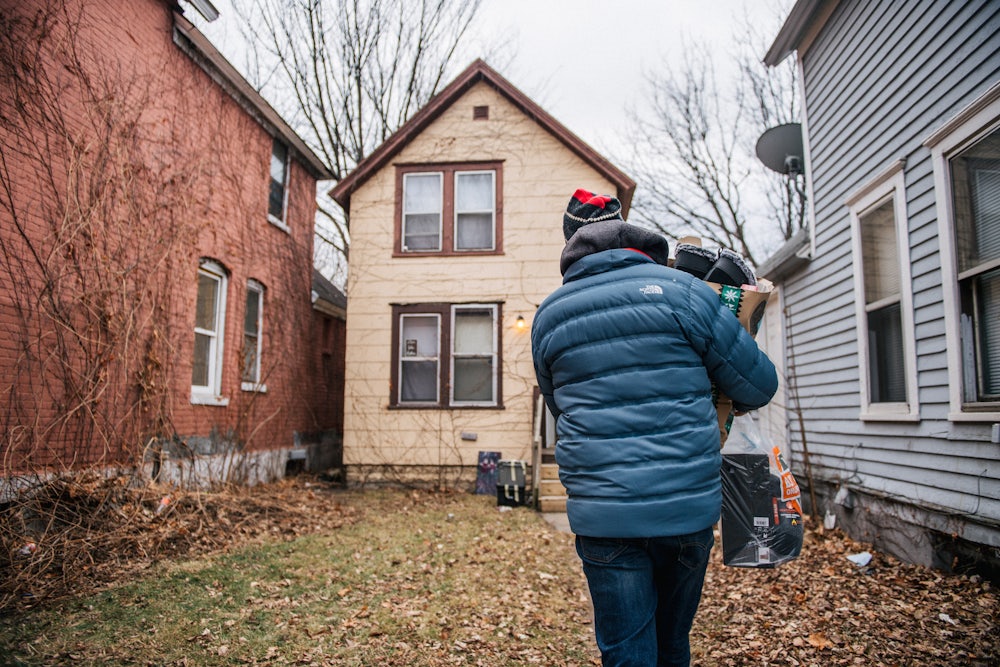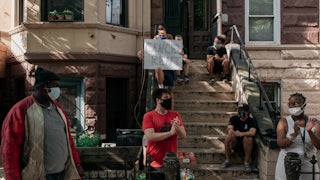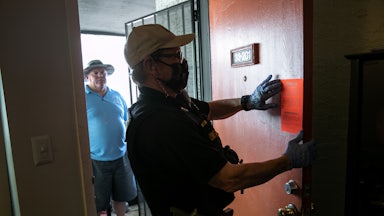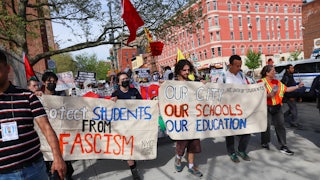For Danielle Swift, the need for rent control in St. Paul, Minnesota gained new urgency at the end of 2020, when her mother suddenly received a massive rent increase. Swift, an organizer with the Frogtown Neighborhood Association, suspects that her mother’s landlord decided to increase her rent after she informed her landlord of a maintenance issue. “My mom ended up moving a roommate in, which she wasn’t supposed to do, but she didn’t really have too many options,” Swift told me.
By then, a coalition of St. Paul housing rights groups, including the Frogtown Neighborhood Association, had already been strategizing on a campaign to enact rent control in their city of 300,000; that campaign, Keep St. Paul Home, was launched in March of 2021. The goal was ambitious—to pass the broadest rent control initiative in the country, one that would cap annual rent increases at three percent and, unlike similar rent control laws in cities and states around the country, would include new rental housing under its protections. “The pandemic gave us this sense of, we can’t wait any longer,” said Keep St. Paul Home Campaign Manager Tram Hoang.
According to statistics compiled by the coalition Housing Equity Now St. Paul, more than half of all residents in the city rent their homes, and its renters are disproportionately Black, Native, Latino, and Asian. Despite the city’s reputation for affordability, according to Hoang, renters of color, in particular Black renters, and poorer residents were increasingly being hit with rental increases that they couldn’t afford: a form of slow-moving eviction. A recent study by Harvard University’s Joint Center for Housing Studies found that one in four renters in the Twin Cities spend at least half of their income on rent. When housing organizers talked to renters about needed tenant protections, said Hoang, they were often told, “You know, a security deposit limit would be great. But is there anything that protects me from my rent going up $500?” Swift echoed Hoang. “I knew that this was an issue that a lot of people were experiencing, especially because the market is so hot,” Swift said.
Their first step was to collect enough signatures to put a ballot initiative before voters, a requirement imposed by a 1984 state law that barred cities from enacting rent control measures unless approved by voters. After they cleared that barrier, the campaign was faced with another: an opposition led by a landlord lobby group that would go on to raise almost $4 million to fight the rent control initiative—compared to the mere $200,000 spent by the Keep St. Paul Home campaign. But in November, Keep St. Paul Home won. Come May of next year, St. Paul will have the strongest rent control protections of any city in the entire country.
Organizers of St. Paul are not the only ones who are turning to rent control as a necessary tool to combat the housing affordability crisis. Eviction moratoriums and a massive influx of rental assistance helped keep people in their homes during the early stages of the pandemic, but their temporary nature has served to highlight the precarious existence of many renters. Evictions are once again rising, even as, contrary to the sob stories we’ve heard repeatedly through the pandemic, studies have found that landlords collected rent during the pandemic at rates roughly on par as before. (Not to mention that rental relief did little to shift power back to renters. As Tara Raghuveer, the director of the advocacy group KC Tenants in Kansas City, Missouri, recently told The New York Times, “Rental assistance was not designed for tenants; rental assistance was designed to stabilize an industry.”) In neighboring Minneapolis, voters also approved a ballot initiative that would give City Council the ability to enact rent control. In October, the Santa Ana City Council narrowly passed a rent control bill, becoming the first city in Orange County to do so. And Boston’s new progressive mayor Michelle Wu campaigned in part on a platform to reinstate rent control, which was banned throughout the state of Massachusetts in 1994 after a landlord-driven campaign.
The renewed movement for rent control is pushing back against conventional wisdom. For decades, the dominant perspective on rent control policies has been that they don’t work—and that they actually lead to a loss of affordable housing. This analysis is, as housing organizers have long argued, not only shortsighted, but completely misses the point. Hoang and Swift see rent control as one of many necessary policies to stabilize neighborhoods and prevent displacement of working-class renters of color, now rather than when it’s too late. They recognize the need to build new housing. “We get it, we know that we need housing stock,” Swift told me. “We absolutely need the development. But we don’t want to displace people because of it.” Hoang compares rent control to efforts to increase the minimum wage. “Minimum wage is to labor as rent stabilization is to housing—you just have to have some kind of baseline protection to protect those who are going to be most targeted by discriminatory rental increases,” she said.
Increasingly, pundits and economists are coming around to that perspective. As Vox’s Jerusalem Demsas wrote recently in a piece on why she now supports rent control policies, working-class tenants can’t wait for a hypothetical future where housing is affordable and in plentiful supply. “It’s become abundantly clear that even if states do begin to build more homes, it will take years if not decades to rebalance supply and make housing more affordable, and in the meantime millions of families will continue to suffer,” Demsas wrote. She concluded, “Without rent control, the losers are people with less money; those who cannot afford increases in rent are forced out of their neighborhoods, and people who can afford them get to stay or move in. Rent control gives policymakers a chance to redistribute the pains of scarcity in the near term.”
But there are entrenched and very affluent powers who don’t want to see rent control make a comeback. Take California’s multiple failed ballot initiatives to make it possible for municipalities to expand rent control, where housing advocates were outspent two to one by real estate interests. After the results of St. Paul, developers threatened to pull out of projects in the city: a move which Hoang described as nothing more than political scaremongering. Before the pandemic, Hoang worked on a campaign to pass a suite of zoning changes in nearby Minneapolis; in 2019, the city council there approved the plan to eliminate single-family zoning as well as require developers to include a modest amount of affordable housing in new projects. “I remember conversations where developers were like, we are literally leaving the city and never building again if you pass this,” Hoang said. “And it’s 2021, even in a pandemic, we are still seeing record-setting numbers in terms of development permits in the city of Minneapolis.”
A crucial lesson of efforts like Keep St. Paul Home is that a hypothetical future of housing abundance won’t happen unless renters are organized and can form a bloc powerful enough to combat the real estate lobby. In St. Paul, Swift told me, their renewed housing movement is only beginning. “I knew that that was just the first thing,” she said. “The buck does not stop here. There’s much more work to be done. But this is a protection so that people can at least breathe for a second.”










